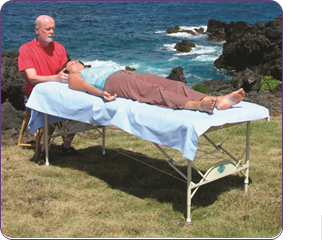What is Reiki?
 The awareness that an unseen energy flows through all living things and directly affects the quality of a person’s health has been part of the wisdom of many cultures since ancient times. This life energy goes by many names: qi in China, ki in Japan, and prana in India. The ancient Hawaiians called it ti or ki. It has also been called orgone energy and élan vital, and science refers to it as biofield energy.
The awareness that an unseen energy flows through all living things and directly affects the quality of a person’s health has been part of the wisdom of many cultures since ancient times. This life energy goes by many names: qi in China, ki in Japan, and prana in India. The ancient Hawaiians called it ti or ki. It has also been called orgone energy and élan vital, and science refers to it as biofield energy.
When your life energy is low, it is more difficult to deal with stress; you may not sleep well, and you’re more susceptible to illness. When your life energy is strong, you feel strong, can more easily deal with stress, and are less likely to get sick. Reiki is a technique that increases a person’s supply of life energy.
What is a Session Like?
Reiki is administered through the hands of a Reiki practitioner with the client lying fully clothed on a massage table. A session usually lasts between 45 minutes to an hour and a half and shorter sessions are also possible.
The Reiki Practitioner places his or her hands at locations around the head and shoulders, the abdomen and on the legs and feet. Tissue is not manipulated. The practitioner’s hands are simply held at each location, lightly touching or slightly away from the body. Reiki energy flows from the practitioner’s hands and into the client’s body and energy field. A Reiki session feels like a wonderful glowing radiance that surrounds and fills the client and includes feelings of relaxation, peace and well-being that also promote healing.
Benefits
Reiki energy allows muscles to relax and increases blood flow to treated areas, which in turn quickens the healing process. Practitioners and clients report help with stress, headaches, insomnia, upset stomach, sprains and other minor conditions. Occasionally, miraculous results are reported. Reiki also promotes psychological healing, including release of anger, fear, worry, sadness and other unhealthy feelings, and replaces them with self-worth, confidence and tranquility.
Reiki is becoming increasingly popular with the medical community, with over 800 hospitals across the U.S. offering Reiki as a standard part of hospital care. A research study at Hartford Hospital in Hartford, Connecticut indicates that Reiki improved patient sleep by 86 percent, reduced pain by 78 percent, reduced nausea by 80 percent, and reduced anxiety during pregnancy by 94 percent. In addition, nurses report that Reiki help patients heal faster with less pain, reduces stress and improves mental attitude, improves appetite, and reduces the negative side effects of chemotherapy, radiation and other medical procedures.
Reiki Classes
Classes are available for those wishing to learn how to give Reiki sessions. Reiki is simple and easy to learn; anyone can learn it, and there are no prerequisites. Once you’ve learned, you can give Reiki to yourself or to others. Teacher training classes are also available.
History
Reiki was developed in Japan in 1922 by Mikao Usui and was brought to the West in 1937 by Hawayo Takata. The popularity of Reiki has grown exponentially in the past few decades.
Come meet Lori, our newest instructor, at Alpine Integrated Medicine’s Saturday Yoga class at 9am or contact us to schedule a session. As always, the complete Yoga schedule can be found on our website, www.alpineintegratedmedicine.com.

